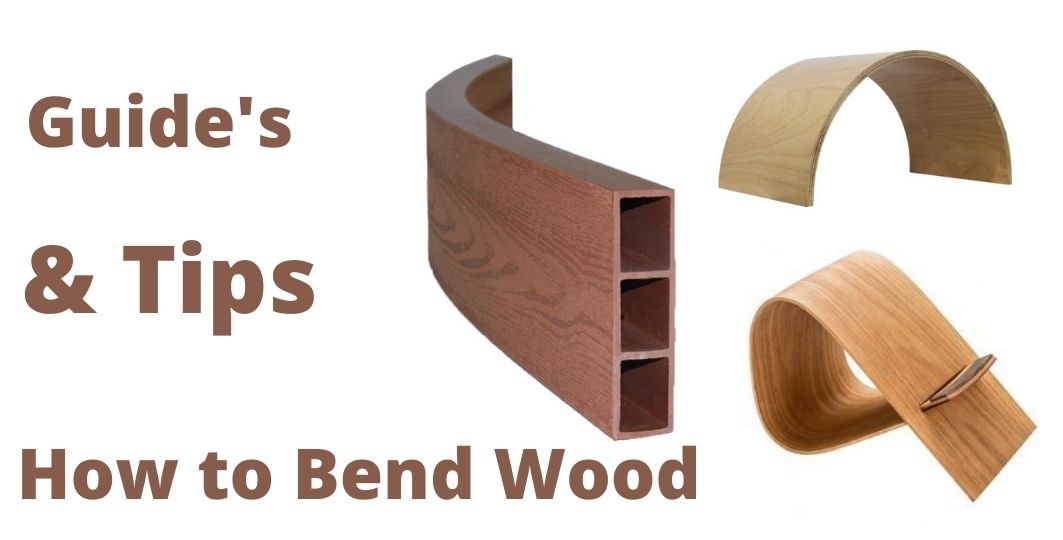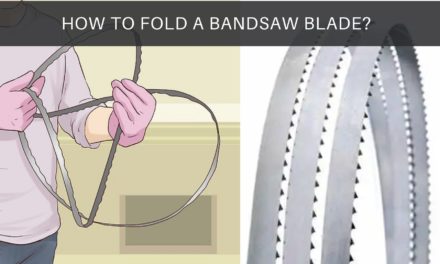Are you interested in learning how to bend thick wood? If your answer is yes, then you’re in the right place. In this article, we will be exposing you to a comfortable method of bending thick wood.
Many people wonder how woodwork professionals can get curved designs when making furniture and wood projects. If you’re one of those with this thought, then you are about to learn what it takes or how to do it.
How to Bend Thick Wood Without Breaking It?
We want to show you how you can bend wood via the bent lamination process. Now, what is bent lamination? A bent lamination process involves using multiple layers of strips bent around a form with glue in between them and clamped down to the form to create the shape of the bending form when the glue dries. You also need to know how to soften wood for bending.
1. Make a bending form:
The first step is to make a bending form. To make the bending form, you have to cut your outside radius or any shape that you want to bend your wood to. Then you cut an inside radius small enough so that the clamps you’ll be using can reach over your bending form and the workpiece that you’ll be bending, clamping them down firmly.
2. Rip strips:
After making your bending form, the next step is to rip your strips. If you’re using a table saw, you should be aware that your strips can be pulled down into your table through the throat plate. To avoid this unfavorable scenario, replace your throat plate with a zero-clearance throat plate. Once you replace the throat plate, you can now rip your strips.
Set the gauge on the rip fence to the closest one-eighth of an inch mark that cuts the least amount of material off your wood.
3. Shape the edge of the board:
After setting the gauge on the rip fence, shape the edge of the board. You will be making one-eighth of an inch strip. Follow this process to get as many pieces as you need. This process gives you comfortable and bendable one-eighth-inch strips. If you use the same measurement for all the strips, each of them will be consistent.
4. Get some glue:
Get some glue and a roller to apply the glue to the strips. You can pour the glue into a tray and from it, dip the roller in then apply it to the strips. Apply glue lightly to each piece. Continue this process until you cover each strip with glue then clip them onto each other until you get the desired thickness.
While doing this, it would be best to have all your materials available because the process requires a limited amount of time. If you exceed this amount of time, it may become difficult to bend the wood.
You should also try to avoid the standard wood glue for bent laminations. Standard wood glue seems not to be ideal or effective for this purpose. It gets soft quickly, but you need your wood hard for wood-making projects.
If you are looking for ideal glue, you can consider epoxy. This is suitable for this purpose but more expensive than the standard glue. Cheaper but equally effective glue is the urea-formaldehyde glue. This glue takes longer to dry, but when it does, it results in hardwood.
5. Clamp the strips to your bending form:
The next step is to clamp all your strips to your bending form or form (for easier understanding). Place the wood on the form. It would be best if you had a buffer between the wood you are bending and the form.
A pad or buffer is to protect the wood from marks that the clamp may produce from the pressure applied for firmness. Also, if there is glue on the surface of the strip, it can react with the steel from the clamp to leave dark marks on the strip. Now clamp the pad and the wood to the form.
6. Lay the wood down:
Lay the form down along with the clamp and the strips. Continue to use more clamps to clamp the strips until you reach both ends. Leave for at least 8 hours.
7. Unclamp the strips:
After this amount of time (about 8 hours), unclamp the form. If you perform the process excellently, you should get wood that is consistent with the shape of your form.
Watch More:
Tips to help with thick wood bending:
The following tips will be helpful if you are trying to bend thick wood.
Make all materials available:
Before you start the process, ensure that all the materials you’ll need for the task are available. You do not have the luxury of time when it comes to this project. For this task, you need some glue, a roller, clamps, and even your table saw, inclusive of a zero-clearance throat plate.
Make one-eight inch strips:
The reason for making one-eighth-inch strips is to create bendable wood. As you know, thick workpieces or boards are difficult to bend. However, thin boards are bendable- that is easy to bend. This is why you need to make strips first before thinking of making bentwood.
Avoid the normal glue:
When performing this task, it is necessary to use glue different from the normal ones used for wood projects. The ideal glue is epoxy. It may be a bit more expensive than your standard glue, but it is much better to choose this as it delivers excellent results. Another wonderful option is Urea-formaldehyde glue. Any of these two can suffice for the project.
What wood is suitable for bending?
Woods that are suitable for bending usually have a number of characteristics in common. When selecting a wood species for bending, it is best to consult with a woodworking expert or lumber professional to ensure the best possible results. They can advise you on the right combination of species and preparation that is needed for your project. It is also important to keep in mind that wood bending often requires specialized tools, so be sure to factor in this cost when estimating the amount of material required. Here you will get an idea about What wood is suitable for bending:
1. Softwoods:
Softwoods are some of the most common types of wood used for bending. The most popular softwood choices include pine, fir, spruce, cedar and redwood. These woods tend to be lightweight and relatively flexible, making them easier to shape into curved forms. However, they can be prone to splitting or cracking as they dry out over time.
2. Hardwoods:
Hardwoods such as oak, maple and walnut are much denser than softwoods and require more force to bend them. However, their superior strength makes them suitable for furniture applications where the bent pieces must support a lot of weight or stress. They won’t split or crack in the same way that softwoods do either, so they can be a better choice for outdoor applications where the pieces will be exposed to harsh weather conditions.
3. Exotic Woods:
Exotic woods such as teak, purpleheart and mahogany are also suitable for bending. These woods tend to have an interesting grain pattern that adds visual appeal to any project. They are generally denser than softwoods or hardwoods and require more force to bend them into shape. However, their superior strength makes them suitable for both indoor and outdoor projects. Additionally, these woods typically don’t shrink or swell as much with changes in humidity or temperature, making them ideal for curved forms that must maintain their shape over time.
4. Plywood and Laminated Strips:
Plywood and laminated strips are also suitable for bending. Thin layers of wood glued together to create strong, flexible panels that can be bent into a variety of shapes. Plywood is often used in furniture applications where the wood must maintain its curved form over time. Laminated strips are ideal for creating decorative curves on the surface of larger pieces, such as tabletops or doors. Both materials require special techniques and tools to bend them effectively.
5. Engineered Woods:
Engineered woods such as MDF and particle board are also popular choices for bending. These materials can be made from a variety of different types of wood fibers, including softwoods, hardwoods, and even recycled materials. Their superior strength makes them suitable for both interior and exterior applications where the curved pieces must support significant weight or stress. Additionally, engineered woods tend to be more dimensionally stable than solid woods so they won’t warp or deform easily over time. However, these materials require specialized tools to bend them effectively and can be difficult to work with if you don’t have experience.
6. Bamboo:
Bamboo is also a popular choice for bending. This wood has many of the same properties as hardwoods, but it’s much more environmentally friendly since it’s a rapidly renewable resource. It’s lightweight yet strong and can easily be bent into curved forms. Like other woods, bamboo requires specialized tools to bend it effectively. However, once you master the technique, you can create beautiful curves with this versatile material.
No matter which type of wood you choose, it’s important to remember that the best results come from using the right tools and techniques. With some practice and patience, you can create beautiful curved forms with any type of wood.
FAQs:
Q. What kind of wood is best for bending thick wood?
A. Hardwoods like oak, maple, and walnut are often used for bending thick wood because they have a high density and can withstand more tension than other kinds of woods such as softwoods like pine.
Q. How do you bend thick wood?
A. Bending thick wood requires specialized tools and techniques, such as steaming or laminating the wood with moisture-retained adhesives to make it pliable enough to be bent into shape without breaking or cracking.
Q. What are some tips when working with thick wood?
A. When working with thick wood, take extra care to avoid damaging the surface of the wood. Make sure to use a saw that has sharp blades and sand the edges with fine-grit sandpaper to prevent splintering. Additionally, when bending thick wood, always use clamps to keep it in place as you work.
Q. What is the best way to protect bent thick wood?
A. To protect bent thick wood, finish it with an appropriate sealant or varnish that will resist moisture and abrasion. If possible, store the piece indoors in a dry area away from direct sunlight to minimize any potential damage. Additionally, inspect your piece regularly for signs of wear and tear to ensure its longevity.
Final Verdict:
The process above is a convenient and straightforward method on how to bend thick wood. There is another process called the wood steaming procedure. As a beginner in the woodwork industry, you may find this process challenging, and it may not produce the desired result. So, we decided to stick to this process.
Related Articles



















